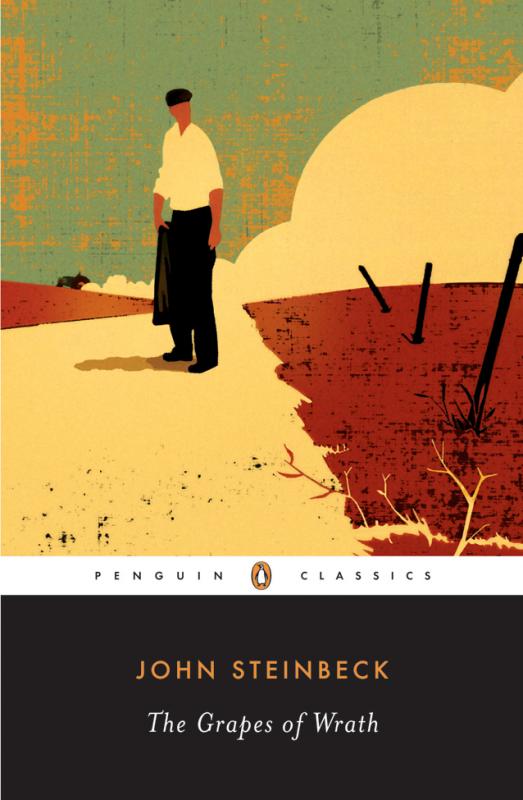Ten Things You Might Not Know about The Grapes of Wrath

Since the day it was published on April 14, 1939, The Grapes of Wrath has captured the American imagination, pulling back the curtain on a way of life that most of us could scarcely imagine, and showing us the powerful ways that literature can touch society. Below are ten facts about John Steinbeck’s masterpiece, which is available as part of the 2021-2022 National Endowment for the Arts Big Read. Applications are due January 27!
Did you know…? The novel was inspired by Steinbeck’s journalism work, particularly for The San Francisco News, which commissioned him to cover migrant labor camps in California’s Salinas Valley. The seven-article series, called “The Harvest Gypsies,” ran in October 1936, and described the desperate conditions migrant farm workers—most of them Dust Bowl refugees—often faced, including hunger, squalid living quarters, and wage exploitation. The camps Steinbeck visited, and the people he met there, fueled much of his vision for The Grapes of Wrath.
Did you know…? The book was an immediate critical and commercial smash. It sold over 400,000 copies in its first year of publication, with The New York Times calling it “a magnificent novel of America.” The book’s merits were so obvious that Steinbeck was awarded the Pulitzer Prize in Fiction in 1940.
Did you know…? The book also had another, very influential fan: First Lady Eleanor Roosevelt. In Roosevelt’s nationally syndicated newspaper column, “My Day,” which ran six days a week, she wrote: “Now I must tell you that I have just finished a book which is an unforgettable experience in reading. The Grapes of Wrath by John Steinbeck, both repels and attracts you. The horrors of the picture, so well drawn, make you dread sometimes to begin the next chapter, and yet you cannot lay the book down or even skip a page.” The book spurred the First Lady to see the living conditions at labor camps for herself; after her visit, she defended the accuracy of Steinbeck’s descriptions. The book, and Roosevelt’s support, even helped lead to Congressional hearings about labor law reforms and wage regulation.
Did you know…? The book’s impact continues: today, the book has sold roughly 14 million copies.
Did you know…? But not everyone was initially on board. In fact, in many communities The Grapes of Wrath was banned and burned, both for its occasional obscene language and its general themes. Some viewed it as communist propaganda, and many farmers and agricultural groups were irate that it fomented anger about their labor practices—the book was “a pack of lies,” the Associated Farmers of California declared. Steinbeck received regular threats following the book’s publication, and took to carrying a gun in public, just in case.
Did you know…? Although Steinbeck spent years researching The Grapes of Wrath, the actual writing process came in a burst: he wrote the 619-page opus—in longhand, mind you—in a mere five months (his first wife, Carol, typed it up).
Did you know…? The Grapes of Wrath is actually one of the original National Endowment for the Arts Big Read books! Our list of NEA Big Read titles has changed significantly since the program launched in 2006, and even The Grapes of Wrath was briefly archived. However, it is back in action for 2021-2022 and available for communities to select for their Big Read programming.
Did you know…? The book’s title was suggested by Steinbeck’s wife, Carol, and comes from the Julia Ward Howe’s “Battle Hymn of the Republic,” which was first published in 1862 and served as a call to arms for the abolitionist movement. The song’s opening lines are as follows: “Mine eyes have seen the glory of the coming of the Lord / He is trampling out the vintage where the grapes of wrath are stored / He hath loosed the fateful lightning of his terrible swift sword / His truth is marching on.”
Did you know…? The Weedpatch Camp, which is described in The Grapes of Wrath, not only still exists, but is listed on the National Register of Historic Places because of the role it played in the Dust Bowl migration. Part of the book’s dedication—“To Tom, who lived it”—refers to Tom Collins, who managed the federal camp, and hosted Steinbeck several times during the author’s research for “The Harvest Gypsies” series. The pair also traveled throughout the San Joaquin Valley conducting fieldwork, and Steinbeck relied heavily on Collins’s official reports when writing The Grapes of Wrath. In addition to his nod in the book’s dedication, Collins serves as the basis for the character Jim Rawley in the novel.
Did you know…? Like many great works of art, The Grapes of Wrath spawned other artworks as well, including Woody Guthrie’s song “Tom Joad,” Bruce Springsteen’s “The Ghost of Tom Joad,” and the 1940 film The Grapes of Wrath, which won Academy Awards for best director and best supporting actress.




